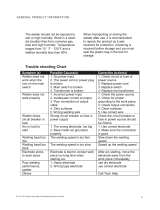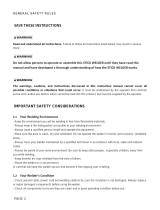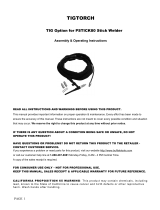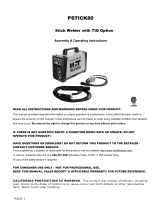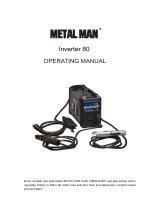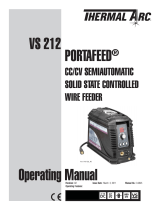Page is loading ...

Version No: 1 Issue Date: November 30, 2005 Manual No.: 0-4835
Operating Features:
INVERTER ARC
WELDER
SMAW
1/3
PHASE
208
V
230
V
460
V
LM-200
Operating Manual

WE APPRECIATE YOUR BUSINESS!
Congratulations on your new Thermal Arc product. We are proud to
have you as our customer and will strive to provide you with the
best service and reliability in the industry. This product is backed by
our extensive warranty and world-wide service network. To locate
your nearest distributor or service agency call
1-800-752-7621, or visit us on the web at www.Thermalarc.com.
This Operating Manual has been designed to instruct you on the
correct use and operation of your Thermal Arc product. Your
satisfaction with this product and its safe operation is our ultimate
concern. Therefore please take the time to read the entire manual,
especially the Safety Precautions. They will help you to avoid potential
hazards that may exist when working with this product.
YOU ARE IN GOOD COMPANY!
The Brand of Choice for Contractors and Fabricators Worldwide.
Thermal Arc is a Global Brand of Arc Welding Products for
Thermadyne Industries Inc. We manufacture and supply to major
welding industry sectors worldwide including; Manufacturing,
Construction, Mining, Automotive, Aerospace, Engineering, Rural
and DIY/Hobbyist.
We distinguish ourselves from our competition through market-
leading, dependable products that have stood the test of time. We
pride ourselves on technical innovation, competitive prices, excellent
delivery, superior customer service and technical support, together
with excellence in sales and marketing expertise.
Above all, we are committed to develop technologically advanced
products to achieve a safer working environment within the welding
industry.

WARNINGS
Read and understand this entire Manual and your employer’s safety practices before installing,
operating, or servicing the equipment.
While the information contained in this Manual represents the Manufacturer's best judgement,
the Manufacturer assumes no liability for its use.
LM-200 Inverter Arc Welder
Operation Manual Number 0-4835 for:
Part Number 10-3092
Published by:
Thermadyne Industries, Inc.
82 Benning Street
West Lebanon, New Hampshire, USA 03784
(603) 298-5711
www.thermalarc.com
©Copyright 2005 by
Thermadyne Industries, Inc.
All rights reserved.
Reproduction of this work, in whole or in part, without written permission of the pub-
lisher is prohibited.
The publisher does not assume and hereby disclaims any liability to any party for any
loss or damage caused by any error or omission in this Manual, whether such error
results from negligence, accident, or any other cause.
Publication Date: November 30, 2005
Record the following information for Warranty purposes:
Where Purchased: ___________________________________
Purchase Date: ___________________________________
Equipment Serial #: ___________________________________
i

TABLE OF CONTENTS
SECTION 1:
SAFETY INSTRUCTIONS AND WARNINGS ....................................................... 1-1
1.01 Arc Welding Hazards ...................................................................................... 1-1
1.02 Principal Safety Standards ............................................................................. 1-4
1.03 Precautions de Securite en Soudage à l’Arc ................................................... 1-5
1.04 Dangers Relatifs au Soudage à l’Arc............................................................... 1-5
1.05 Principales Normes de Securite ..................................................................... 1-8
2.01 How To Use This Manual ................................................................................ 2-1
SECTION 2:
INTRODUCTION ...................................................................................... 2-1
2.02 Equipment Identification................................................................................. 2-1
2.03 Receipt Of Equipment..................................................................................... 2-1
2.04 Symbol Chart ................................................................................................. 2-2
2.05 Description ..................................................................................................... 2-3
2.06 Functional Block Diagram............................................................................... 2-4
2.07 Transporting Methods .................................................................................... 2-5
2.08 Electrical Input Connections ........................................................................... 2-6
2.09 Specifications ................................................................................................. 2-9
2.10 Duty Cycle .................................................................................................... 2-10
SECTION 3:
OPERATION ........................................................................................... 3-1
3.01 LM-200 DC CC Views ..................................................................................... 3-1
3.02 Weld Parameter Descriptions for Pro-Plus LM-200 ....................................... 3-4
3.03 Weld Process selection for the LM-200.......................................................... 3-6
3.04 Weld Parameter Descriptions ......................................................................... 3-7
3.05 Weld Parameters ............................................................................................ 3-9
3.06 Power Source Features................................................................................. 3-10
SECTION 4:
SAVE/LOAD OPERATION ........................................................................... 4-1
4.01 SEQUENCE OF OPERATION ............................................................................ 4-1
4.02 Save / Load Operation .................................................................................... 4-2
4.03 LOAD Operation.............................................................................................. 4-2

TABLE OF CONTENTS (continued)TABLE OF CONTENTS
SECTION 5: BASIC MAINTENANCE AND TROUBLESHOOTING ...................................... 5-1
5.01 Basic Maintenance ......................................................................................... 5-1
5.02 General Troubleshooting ................................................................................ 5-2
5.03 Common Welding Operation Faults ................................................................ 5-2
5.04 Solving MIG Problems Beyond the Welding Terminals................................... 5-3
5.05 MIG Welding Problems .................................................................................. 5-5
5.06 TIG Welding Problems ................................................................................... 5-6
5.07 Stick Welding Problems ................................................................................. 5-8
5.08 Power Source Problems............................................................................... 5-10
5.09 Error Codes .................................................................................................. 5-11
5.10 Voltage Reduction Device (VRD) .................................................................. 5-13
5.11 VRD Maintenance ......................................................................................... 5-13
5.12 Switching VRD On/Off .................................................................................. 5-14
APPENDIX 1: OPTIONS AND ACCESSORIES ........................................................... A-1
APPENDIX 2: SYSTEM SCHEMATIC ..................................................................... A-2
LIMITED WARRANTY
WARRANTY SCHEDULE
GLOBAL CUSTOMER SERVICE CONTACT INFORMATION .......................... Inside Rear Cover

LM-200 INVERTER ARC WELDER
1-1
November 30, 2005
7. Use fully insulated electrode holders. Never dip holder in water to
cool it or lay it down on the ground or the work surface. Do not
touch holders connected to two welding machines at the same
time or touch other people with the holder or electrode.
8. Do not use worn, damaged, undersized, or poorly spliced cables.
9. Do not wrap cables around your body.
10. Ground the workpiece to a good electrical (earth) ground.
11. Do not touch electrode while in contact with the work (ground)
circuit.
12. Use only well-maintained equipment. Repair or replace damaged
parts at once.
13. In confined spaces or damp locations, do not use a welder with
AC output unless it is equipped with a voltage reducer. Use
equipment with DC output.
14. Wear a safety harness to prevent falling if working above floor
level.
15. Keep all panels and covers securely in place.
WARNING
ARC RAYS can burn eyes and skin; NOISE can damage
hearing. Arc rays from the welding process produce
intense heat and strong ultraviolet rays that can burn
eyes and skin. Noise from some processes can damage
hearing.
1. Wear a welding helmet fitted with a proper shade of filter (see
ANSI Z49.1 listed in Safety Standards) to protect your face and
eyes when welding or watching.
2. Wear approved safety glasses. Side shields recommended.
1.01 Arc Welding Hazards
WARNING
ELECTRIC SHOCK can kill.
Touching live electrical parts can cause fatal shocks or
severe burns. The electrode and work circuit is electrically
live whenever the output is on. The input power circuit
and machine internal circuits are also live when power
is on. In semiautomatic or automatic wire welding, the
wire, wire reel, drive roll housing, and all metal parts
touching the welding wire are electrically live. Incorrectly
installed or improperly grounded equipment is a hazard.
1. Do not touch live electrical parts.
2. Wear dry, hole-free insulating gloves and body protection.
3. Insulate yourself from work and ground using dry insulating mats
or covers.
4. Disconnect input power or stop engine before installing or
servicing this equipment. Lock input power disconnect switch
open, or remove line fuses so power cannot be turned on
accidentally.
5. Properly install and ground this equipment according to its Owner’s
Manual and national, state, and local codes.
6. Turn off all equipment when not in use. Disconnect power to
equipment if it will be left unattended or out of service.
SECTION 1:
SAFETY INSTRUCTIONS AND WARNINGS
!
WARNING
PROTECT YOURSELF AND OTHERS FROM POSSIBLE SERIOUS INJURY OR DEATH. KEEP CHILDREN AWAY. PACEMAKER WEARERS KEEP
AWAY UNTIL CONSULTING YOUR DOCTOR. DO NOT LOSE THESE INSTRUCTIONS. READ OPERATING/INSTRUCTION MANUAL BEFORE
INSTALLING, OPERATING OR SERVICING THIS EQUIPMENT.
Welding products and welding processes can cause serious injury or death, or damage to other equipment or property, if the operator does not
strictly observe all safety rules and take precautionary actions.
Safe practices have developed from past experience in the use of welding and cutting. These practices must be learned through study and
training before using this equipment. Some of these practices apply to equipment connected to power lines; other practices apply to engine
driven equipment. Anyone not having extensive training in welding and cutting practices should not attempt to weld.
Safe practices are outlined in the American National Standard Z49.1 entitled:
SAFETY IN WELDING AND CUTTING. This publication and other
guides to what you should learn before operating this equipment are listed at the end of these safety precautions. HAVE ALL INSTALLATION,
OPERATION, MAINTENANCE, AND REPAIR WORK PERFORMED ONLY BY QUALIFIED PEOPLE.

LM-200 INVERTER ARC WELDER
1-2
November 30, 2005
3. Use protective screens or barriers to protect others from flash
and glare; warn others not to watch the arc.
4. Wear protective clothing made from durable, flame-resistant
material (wool and leather) and foot protection.
5. Use approved ear plugs or ear muffs if noise level is high.
WARNING
FUMES AND GASES can be hazardous to your health.
Welding produces fumes and gases. Breathing these
fumes and gases can be hazardous to your health.
1. Keep your head out of the fumes. Do not breath the fumes.
2. If inside, ventilate the area and/or use exhaust at the arc to remove
welding fumes and gases.
3. If ventilation is poor, use an approved air-supplied respirator.
4. Read the Material Safety Data Sheets (MSDSs) and the
manufacturer’s instruction for metals, consumables, coatings, and
cleaners.
5. Work in a confined space only if it is well ventilated, or while
wearing an air-supplied respirator. Shielding gases used for
welding can displace air causing injury or death. Be sure the
breathing air is safe.
6. Do not weld in locations near degreasing, cleaning, or spraying
operations. The heat and rays of the arc can react with vapors to
form highly toxic and irritating gases.
7. Do not weld on coated metals, such as galvanized, lead, or
cadmium plated steel, unless the coating is removed from the
weld area, the area is well ventilated, and if necessary, while
wearing an air-supplied respirator. The coatings and any metals
containing these elements can give off toxic fumes if welded.
WARNING
WELDING can cause fire or explosion.
Sparks and spatter fly off from the welding arc. The flying
sparks and hot metal, weld spatter, hot workpiece, and
hot equipment can cause fires and burns. Accidental
contact of electrode or welding wire to metal objects
can cause sparks, overheating, or fire.
1. Protect yourself and others from flying sparks and hot metal.
2. Do not weld where flying sparks can strike flammable material.
3. Remove all flammables within 35 ft (10.7 m) of the welding arc.
If this is not possible, tightly cover them with approved covers.
4. Be alert that welding sparks and hot materials from welding can
easily go through small cracks and openings to adjacent areas.
5. Watch for fire, and keep a fire extinguisher nearby.
6. Be aware that welding on a ceiling, floor, bulkhead, or partition
can cause fire on the hidden side.
7. Do not weld on closed containers such as tanks or drums.
8. Connect work cable to the work as close to the welding area as
practical to prevent welding current from traveling long, possibly
unknown paths and causing electric shock and fire hazards.
9. Do not use welder to thaw frozen pipes.
10. Remove stick electrode from holder or cut off welding wire at
contact tip when not in use.
Welding or cutting Electrode Size Filter Welding or cutting Electrode Size Filter
Torch soldering 2 Gas metal-arc
Torch brazing 3 or 4 Non-ferrous base metal All 11
Oxygen Cutting Ferrous base metal All 12
Light Under 1 in., 25 mm 3 or 4 Gas tungsten arc welding All 12
Medium 1 to 6 in., 25-150 mm 4 or 5 (TIG) All 12
Heavy Over 6 in., 150 mm 5 or 6 Atomic hydrogen welding All 12
Gas welding Carbon arc welding All 12
Light Under 1/8 in., 3 mm 4 or 5 Plasma arc welding
Medium 1/8 to 1/2 in., 3-12 mm 5 or 6 Carbon arc air gouging
Heavy Over 1/2 in., 12 mm 6 or 8 Light 12
Shielded metal-arc Under 5/32 in., 4 mm 10 Heavy 14
5/32 to 1/4 in., 12 Plasma arc cutting
Over 1/4 in., 6.4 mm 14 Light Under 300 Amp 9
Medium 300 to 400 Amp 12
Heavy Over 400 Amp 14
Eye protection filter shade selector for welding or cutting
(goggles or helmet), from AWS A6.2-73.

LM-200 INVERTER ARC WELDER
1-3
November 30, 2005
WARNING
FLYING SPARKS AND HOT METAL can cause injury.
Chipping and grinding cause flying metal. As welds cool,
they can throw off slag.
1. Wear approved face shield or safety goggles. Side shields
recommended.
2. Wear proper body protection to protect skin.
WARNING
CYLINDERS can explode if damaged.
Shielding gas cylinders contain gas under high pressure.
If damaged, a cylinder can explode. Since gas cylinders
are normally part of the welding process, be sure to treat
them carefully.
1. Protect compressed gas cylinders from excessive heat, mechanical
shocks, and arcs.
2. Install and secure cylinders in an upright position by chaining
them to a stationary support or equipment cylinder rack to prevent
falling or tipping.
3. Keep cylinders away from any welding or other electrical circuits.
4. Never allow a welding electrode to touch any cylinder.
5. Use only correct shielding gas cylinders, regulators, hoses, and
fittings designed for the specific application; maintain them and
associated parts in good condition.
6. Turn face away from valve outlet when opening cylinder valve.
7. Keep protective cap in place over valve except when cylinder is in
use or connected for use.
8. Read and follow instructions on compressed gas cylinders,
associated equipment, and CGA publication P-1 listed in Safety
Standards.
!
WARNING
Engines can be dangerous.
WARNING
ENGINE EXHAUST GASES can kill.
Engines produce harmful exhaust gases.
1. Use equipment outside in open, well-ventilated areas.
2. If used in a closed area, vent engine exhaust outside and away
from any building air intakes.
WARNING
ENGINE FUEL can cause fire or explosion.
Engine fuel is highly flammable.
1. Stop engine before checking or adding fuel.
2. Do not add fuel while smoking or if unit is near any sparks or
open flames.
3. Allow engine to cool before fueling. If possible, check and add
fuel to cold engine before beginning job.
4. Do not overfill tank — allow room for fuel to expand.
5. Do not spill fuel. If fuel is spilled, clean up before starting engine.
WARNING
MOVING PARTS can cause injury.
Moving parts, such as fans, rotors, and belts can cut fingers and hands
and catch loose clothing.
1. Keep all doors, panels, covers, and guards closed and
securely in place.
2. Stop engine before installing or connecting unit.
3. Have only qualified people remove guards or covers for
maintenance and troubleshooting as necessary.
4. To prevent accidental starting during servicing, disconnect
negative (-) battery cable from battery.
5. Keep hands, hair, loose clothing, and tools away from moving
parts.
6. Reinstall panels or guards and close doors when servicing
is finished and before starting engine.
WARNING
SPARKS can cause BATTERY GASES TO EXPLODE;
BATTERY ACID can burn eyes and skin.
Batteries contain acid and generate explosive gases.
1. Always wear a face shield when working on a battery.
2. Stop engine before disconnecting or connecting battery cables.
3. Do not allow tools to cause sparks when working on a battery.
4. Do not use welder to charge batteries or jump start vehicles.
5. Observe correct polarity (+ and –) on batteries.

LM-200 INVERTER ARC WELDER
1-4
November 30, 2005
WARNING
STEAM AND PRESSURIZED HOT COOLANT can burn
face, eyes, and skin.
The coolant in the radiator can be very hot and under
pressure.
1. Do not remove radiator cap when engine is hot. Allow engine to cool.
2. Wear gloves and put a rag over cap area when removing cap.
3. Allow pressure to escape before completely removing cap.
!
WARNING
This product, when used for welding or cutting, produces
fumes or gases which contain chemicals know to the
State of California to cause birth defects and, in some
cases, cancer. (California Health & Safety code Sec.
25249.5 et seq.)
NOTE
Considerations About Welding And The Effects of Low
Frequency Electric and Magnetic Fields
The following is a quotation from the General Conclusions Section of
the U.S. Congress, Office of Technology Assessment, Biological Effects
of Power Frequency Electric & Magnetic Fields - Background Paper,
OTA-BP-E-63 (Washington, DC: U.S. Government Printing Office, May
1989): “...there is now a very large volume of scientific findings based
on experiments at the cellular level and from studies with animals and
people which clearly establish that low frequency magnetic fields
interact with, and produce changes in, biological systems. While most
of this work is of very high quality, the results are complex. Current
scientific understanding does not yet allow us to interpret the evidence
in a single coherent framework. Even more frustrating, it does not yet
allow us to draw definite conclusions about questions of possible risk
or to offer clear science-based advice on strategies to minimize or
avoid potential risks.”
To reduce magnetic fields in the workplace, use the following
procedures:
1. Keep cables close together by twisting or taping them.
2. Arrange cables to one side and away from the operator.
3. Do not coil or drape cable around the body.
4. Keep welding power source and cables as far away from
body as practical.
ABOUT PACEMAKERS:
The above procedures are among those also normally
recommended for pacemaker wearers. Consult your
doctor for complete information.
1.02 Principal Safety Standards
Safety in Welding and Cutting, ANSI Standard Z49.1, from American
Welding Society, 550 N.W. LeJeune Rd., Miami, FL 33126.
Safety and Health Standards, OSHA 29 CFR 1910, from Superintendent
of Documents, U.S. Government Printing Office, Washington, D.C.
20402.
Recommended Safe Practices for the Preparation for Welding and
Cutting of Containers That Have Held Hazardous Substances, Ameri-
can Welding Society Standard AWS F4.1, from American Welding
Society, 550 N.W. LeJeune Rd., Miami, FL 33126.
National Electrical Code, NFPA Standard 70, from National Fire
Protection Association, Batterymarch Park, Quincy, MA 02269.
Safe Handling of Compressed Gases in Cylinders, CGA Pamphlet P-
1, from Compressed Gas Association, 1235 Jefferson Davis Highway,
Suite 501, Arlington, VA 22202.
Code for Safety in Welding and Cutting, CSA Standard W117.2, from
Canadian Standards Association, Standards Sales, 178 Rexdale
Boulevard, Rexdale, Ontario, Canada M9W 1R3.
Safe Practices for Occupation and Educational Eye and Face Protec-
tion, ANSI Standard Z87.1, from American National Standards Insti-
tute, 1430 Broadway, New York, NY 10018.
Cutting and Welding Processes, NFPA Standard 51B, from National
Fire Protection Association, Batterymarch Park, Quincy, MA 02269.

LM-200 INVERTER ARC WELDER
1-8
November 30, 2005
1. Utilisez l’équipement à l’extérieur dans des aires ouvertes et bien
ventilées.
2. Si vous utilisez ces équipements dans un endroit confiné, les
fumées d’échappement doivent être envoyées à l’extérieur, loin
des prises d’air du bâtiment.
AVERTISSEMENT
LE CARBURANT PEUR CAUSER UN INCENDIE OU UNE
EXPLOSION.
Le carburant est hautement inflammable.
1. Arrêtez le moteur avant de vérifier le niveau e carburant ou de
faire le plein.
2. Ne faites pas le plein en fumant ou proche d’une source d’étincelles
ou d’une flamme nue.
3. Si c’est possible, laissez le moteur refroidir avant de faire le plein
de carburant ou d’en vérifier le niveau au début du soudage.
4. Ne faites pas le plein de carburant à ras bord: prévoyez de l’espace
pour son expansion.
5. Faites attention de ne pas renverser de carburant. Nettoyez tout
carburant renversé avant de faire démarrer le moteur.
AVERTISSEMENT
DES PIECES EN MOUVEMENT PEUVENT CAUSER DES
BLESSURES.
Des pièces en mouvement, tels des ventilateurs, des
rotors et des courroies peuvent couper doigts et mains,
ou accrocher des vêtements amples.
1. Assurez-vous que les portes, les panneaux, les capots et les
protecteurs soient bien fermés.
2. Avant d’installer ou de connecter un système, arrêtez le moteur.
3. Seules des personnes qualifiées doivent démonter des protecteurs
ou des capots pour faire l’entretien ou le dépannage nécessaire.
4. Pour empêcher un démarrage accidentel pendant l’entretien,
débranchez le câble d’accumulateur à la borne négative.
5. N’approchez pas les mains ou les cheveux de pièces en
mouvement; elles peuvent aussi accrocher des vêtements amples
et des outils.
6. Réinstallez les capots ou les protecteurs et fermez les portes après
des travaux d’entretien et avant de faire démarrer le moteur.
AVERTISSEMENT
DES ETINCELLES PEUVENT FAIRE EXPLOSER UN
ACCUMULATEUR; L’ELECTROLYTE D’UN ACCUMU-
LATEUR PEUT BRULER LA PEAU ET LES YEUX.
Les accumulateurs contiennent de l’électrolyte acide et
dégagent des vapeurs explosives.
1. Portez toujours un écran facial en travaillant sur un accumu-lateur.
2. Arrêtez le moteur avant de connecter ou de déconnecter des câbles
d’accumulateur.
3. N’utilisez que des outils anti-étincelles pour travailler sur un
accumulateur.
4. N’utilisez pas une source de courant de soudage pour charger
un accumulateur ou survolter momentanément un véhicule.
5. Utilisez la polarité correcte (+ et –) de l’accumulateur.
AVERTISSEMENT
LA VAPEUR ET LE LIQUIDE DE REFROIDISSEMENT
BRULANT SOUS PRESSION PEUVENT BRULER LA
PEAU ET LES YEUX.
Le liquide de refroidissement d’un radiateur peut être
brûlant et sous pression.
1. N’ôtez pas le bouchon de radiateur tant que le moteur n’est pas
refroidi.
2. Mettez des gants et posez un torchon sur le bouchon pour l’ôter.
3. Laissez la pression s’échapper avant d’ôter complètement le
bouchon.
1.05 Principales Normes de Securite
Safety in Welding and Cutting, norme ANSI Z49.1, American Weld-
ing Society, 550 N.W. LeJeune Rd., Miami, FL 33128.
Safety and Health Standards, OSHA 29 CFR 1910, Superintendent of
Documents, U.S. Government Printing Office, Washington, D.C.
20402.
Recommended Safe Practices for the Preparation for Welding and
Cutting of Containers That Have Held Hazardous Substances, norme
AWS F4.1, American Welding Society, 550 N.W. LeJeune Rd., Miami,
FL 33128.
National Electrical Code, norme 70 NFPA, National Fire Protection
Association, Batterymarch Park, Quincy, MA 02269.
Safe Handling of Compressed Gases in Cylinders, document P-1,
Compressed Gas Association, 1235 Jefferson Davis Highway, Suite
501, Arlington, VA 22202.
Code for Safety in Welding and Cutting, norme CSA W117.2 Asso-
ciation canadienne de normalisation, Standards Sales, 276 Rexdale
Boulevard, Rexdale, Ontario, Canada M9W 1R3.
Safe Practices for Occupation and Educational Eye and Face Protec-
tion, norme ANSI Z87.1, American National Standards Institute, 1430
Broadway, New York, NY 10018.
Cutting and Welding Processes, norme 51B NFPA, National Fire Pro-
tection Association, Batterymarch Park, Quincy, MA 02269.

LM-200 INVERTER ARC WELDER
November 30, 2005
2-1
SECTION 2:
INTRODUCTION
2.01 How To Use This Manual
This Owner’s Manual applies to just specification or part
numbers listed on page i.
To ensure safe operation, read the entire manual,
including the chapter on safety instructions and warnings.
Throughout this manual, the words WARNING,
CAUTION, and NOTE may appear. Pay particular attention
to the information provided under these headings. These
special annotations are easily recognized as
follows:
!
WARNING
A WARNING gives information regarding
possible personal injury.
CAUTION
A CAUTION refers to possible equipment
damage.
NOTE
A NOTE offers helpful information concerning
certain operating procedures.
Additional copies of this manual may be purchased by
contacting Thermal Arc at the address and phone number
in your area listed in the inside back cover of this manual.
Include the Owner’s Manual number and equipment
identification numbers.
Electronic copies of this manual can also be downloaded
at no charge in Acrobat PDF format by going to the
Thermal Arc web site listed below and clicking on the
Literature Library link:
http://www.thermalarc.com
2.02 Equipment Identification
The unit’s identification number (specification or part
number), model, and serial number usually appear on a
nameplate attached to the control panel. In some cases,
the nameplate may be attached to the rear panel.
Equipment which does not have a control panel such as
gun and cable assemblies is identified only by the
specification or part number printed on the shipping
container. Record these numbers on the bottom of page
i for future reference.
2.03 Receipt Of Equipment
When you receive the equipment, check it against the
invoice to make sure it is complete and inspect the
equipment for possible damage due to shipping. If there
is any damage, notify the carrier immediately to file a
claim. Furnish complete information concerning damage
claims or shipping errors to the location in your area listed
in the inside back cover of this manual.
Include all equipment identification numbers as described
above along with a full description of the parts in error.
Move the equipment to the installation site before un-
crating the unit. Use care to avoid damaging the
equipment when using bars, hammers, etc., to un-crate
the unit.

LM-200 INVERTER ARC WELDER
2-2
November 30, 2005
2.04 Symbol Chart
Note that only some of these symbols will appear on your model.
Gas Tungsten Arc
Welding (GTAW)
Air Carbon Arc
Cutting (CAC-A)
Constant Current
Constant Voltage
Or Constant Potential
High Temperature
Fault Indication
Arc Force
Touch Start (GTAW)
Variable Inductance
Voltage Input
Single Phase
Three Phase
Three Phase Static
Frequency Converter-
Transformer-Rectifier
Dangerous Voltage
Off
On
Panel/Local
Shielded Metal
Arc Welding (SMAW)
Gas Metal Arc
Welding (GMAW)
Increase/Decrease
Circuit Breaker
AC Auxiliary Power
Remote
Duty Cycle
Percentage
Amperage
Voltage
Hertz (cycles/sec)
Frequency
Negative
Positive
Direct Current (DC)
Protective Earth
(Ground)
Line
Line Connection
Auxiliary Power
Receptacle Rating-
Auxiliary Power
Art # A-04130
115V 15A
t
t1
t2
%
X
IPM
MPM
t
V
Fuse
Wire Feed Function
Wire Feed Towards
Workpiece With
Output Voltage Off.
Preflow Time
Postflow Time
Spot Time
Spot Weld Mode
Continuous Weld
Mode
Press to initiate wirefeed and
welding, release to stop.
Purging Of Gas
Inches Per Minute
Meters Per Minute
Disturbance In
Ground System
Welding Gun
Burnback Time
Press and hold for preflow, release
to start arc. Press to stop arc, and
hold for preflow.
4 Step Trigger
Operation
2 Step Trigger
Operation

LM-200 INVERTER ARC WELDER
November 30, 2005
2-3
2.05 Description
The Thermal Arc™ Pro-Plus LM-200 is a single & three-phase DC arc welding power source with Constant Current
(CC) and Constant Voltage (CV) output characteristics. This unit is equipped with a Digital Volt/Amperage, lift arc
starter for use with Gas Tungsten Arc Welding (GTAW), Arc Control and Hot Start for Shielded Metal Arc Welding
(SMAW), Inductance Control for Gas Metal Arc Welding (GMAW) processes. The power source is totally enclosed in
an impact resistant, flame resistant and non-conductive plastic case
NOTE
Volt-Ampere curves show the maximum Voltage and Amperage output capabilities of the welding power
source . Curves of other settings will fall between the curves shown.
200A1A (A)
(V)
OCV
18V
220A
160A
Art # A-06919
200A25A (A)
(V)
OCV
10V
200A1A (A)
(V)
OCV
10V
220A
28V
Figure 1: Model LM-200 volt-ampere curve

LM-200 INVERTER ARC WELDER
2-4
November 30, 2005
2.06 Functional Block Diagram
To each control circuit
Main
Cir c u i t
Switch
Filter
Input
Dio d e
Ca pa c i t o r
DC Power
Primary
Voltage
Sensor
IGBT
Inverter
Themal
De t ec t o r
Main
Transformers
(T1)
Output
Inductor
Output
Dio d es
Transformer
(HCT1)
Hall Current
Lift Tig Mode
Output Short
Sensing
Cir c u i t
Stick Mode
VRD
Sensing
Cir c u i t
Thermal
Sensor
Cir c u i t
Dri ve
Cir c u i t
+/-15VDC +18VDC
+24VDC +5VDC
Trouble
Sensing
Cir c u i t
14PIN
Re c e pt a c l e
(CON1)
Current
Adjustment
Cir c u i t
Re f er en c e
Adjustment &
Mode select Switch
Panel Circuit Boad
Sequence
Co nt r ol
Fan Control
Cir c u i t
Fa n
Input
Power
Primary
Cir c u i t
Sensor
Do wn
Transformers
AC115V,AC24V
(T3)
Ov er
Current
Protect
19PIN
Re c e pt a c l e
(CON2)
Themal
De t ec t o r
14PIN-19PIN
Select Switch
(S3)
Art # A-06920
Figure 2: LM-200 Model functional block diagram

LM-200 INVERTER ARC WELDER
November 30, 2005
2-5
2.07 Transporting Methods
These units are equipped with a handle for carrying
purposes.
!
WARNING
ELECTRIC SHOCK can kill.
• DO NOT TOUCH live electrical parts.
• Disconnect input power conductors from de-
energized supply line before moving welding power
source.
!
WARNING
FALLING EQUIPMENT can cause serious
personal injury and equipment damage.
• Lift unit with handle or shoulder strap on top of case.
• Use hand cart or similar device of adequate capacity.
• If using a fork lift vehicle, place and secure unit on a
proper skid before transporting.

LM-200 INVERTER ARC WELDER
2-6
November 30, 2005
2.08 Electrical Input Connections
!
WARNING
ELECTRIC SHOCK can kill; SIGNIFICANT DC
VOLTAGE is present after removal of input
power.
• DO NOT TOUCH live electrical parts.
• SHUT DOWN welding power source, disconnect input
power employing lockout/tagging procedures.
Lockout/tagging procedures consist of padlocking
line disconnect switch in open position, removing
fuses from fuse box, or shutting off and redtagging
circuit breaker or other disconnecting device.
Electrical Input Requirements: Operate the welding
power source from a single-phase 50/60 Hz, AC power
supply. The input voltage must match one of the electrical
input voltages shown on the input data label on the unit
nameplate. Contact the local electric utility for information
about the type of electrical service available, how proper
connections should be made, and inspection required.
The line disconnect switch provides a safe and convenient
means to completely remove all electrical power from
the welding power supply whenever necessary to inspect
or service the unit.
NOTE
These units are equipped with a three-
conductor with earth power cable that is
connected at the welding power source end
for single-phase and three-phase electrical
input power.
• To operate signal-phase, do not connect the RED
input conductor.
• Do not connect an input (WHITE, RED or BLACK)
conductor to the ground terminal.
• Do not connect the ground (GREEN) conductor to an
input line terminal.
1. Connect end of ground (GREEN) conductor to a
suitable ground. Use a grounding method that
complies with all applicable electrical codes.
2. Connect ends of line 1 (BLACK) and line 2 (WHITE)
input conductors to a de-energized line disconnect
switch.
3. Use Table 1 and Table 2 as a guide to select line fuses
for the disconnect switch.
NOTE
For Single-Phase operation connect the
GREEN, BLACK and WHITE input conductors.
Insolate the RED Conductor, it is not used for
Single-phase operation.
Input Voltage Fuse Size
208 VAC 60 Amps
230 VAC 50 Amps
460 VAC 30 Amps
Table 1: Electrical Input Connections
NOTE
Fuse size is based on not more than 200
percent of the rated input amperage of the
welding power source (Based on Article 630,
National Electrical Code).

LM-200 INVERTER ARC WELDER
November 30, 2005
2-7
Art # A-06923
Welding Power Supply
Ground Terminal
Ground Conductor
Line Disconect Switch
Line Fuse
Primary Power Cable
Figure 3: Electrical input connections
Input Power: Each unit incorporates an INRUSH circuit and input voltage sensing circuit. When the MAIN CIRCUIT
BREAKER is turned on, the inrush circuit provides a pre-charging of the input capacitors. SCR’s in the Power Control
Assembly (PCA) will turn on after the input capacitors have charged to full operating voltage (after approximately 5
seconds).
NOTE
Note the available input power. Damage to the PCA could occur if 575VAC or higher is applied.

LM-200 INVERTER ARC WELDER
2-8
November 30, 2005
The following 208-230/460V Primary Current recommendations are required to obtain the maximum welding current
and duty cycle from this welding equipment:
Current & Duty Cycle
Model
Primary Supply
Lead Size
Minimum Primary
Current Circuit Size
(Vin/Amps)
MIG TIG STICK
208/39
- -
230/35
- -
460/18
200A @ 60%
-
-
208/29
- -
230/27
- -
460/14
-
200A @ 60%
-
208/45
- -
230/41
- -
8/4 AWG minimum
(Factory Fitted)
3 ?
460/21
- -
200A @ 60%
208/51
- -
230/44
200A @ 60%
-
-
208/37
- -
230/33 -
200A @ 60%
-
208/57
- -
PRO-PLUS
LM-200
8/3 AWG minimum 1 ?
230/51 - -
200A @ 60%
Table 2: Primary Current Circuit sizes to achieve maximum current

LM-200 INVERTER ARC WELDER
November 30, 2005
2-9
2.09 Specifications
Parameter LM-200
Rated Output
Amperes
Volts
Duty Cycle
200
28
60%
200A / 18V @ 60% Duty Cycle TIG
150A / 16V @ 100%
200A / 28V @ 60% STICK
150A / 26V @ 100%
200A / 24V @ 60% MIG
150A / 22V @ 100%
Output Current
Range
TIG
STICK
1 – 200A
Output Voltage
Range
MIG 10 – 28V
Open Circuit Voltage 65V
Dimensions
Width
Height
Length
8.27” (210mm)
16.89” (420mm)
17.72” (450mm)
Weight 59.5 lb. 27.0 kg
Output @ Rated Load
Output Amperes 200A
Output Volts 28V
Duty Cycle 60%
KVA 9.3
KW 7.0
0.5
Output @ No Load
KVA
KW
0.13
Input Volts Single Phase
208V
230V
Amperage Draw @ Rated Load
57
51
No Load
2.4
1.8
Input Volts Three Phase
208V
230V
460V
45
41
21
1.4
1.1
0.7

LM-200 INVERTER ARC WELDER
2-10
November 30, 2005
2.10 Duty Cycle
The duty cycle of a welding power source is the percentage
of a ten (10) minute period that it can be operated at a
given output without causing overheating and damage to
the unit. If the welding amperes decrease, the duty cycle
increases. If the welding amperes are increased beyond
the rated output, the duty cycle will decrease.
!
WARNING
Exceeding the duty cycle ratings will cause the
thermal overload protection circuit to become
energized and shut down the output until the
unit has cooled to normal operating
temperature. Continually exceeding the duty
cycle ratings can cause damage to the welding
power source.
To calculate duty cycle:
current
(rated current) x(rated duty cycle)
(desired duty cycle)
2
Art # A-05167
i.e. At 400A rated output current, and 25% rated duty
cycle, the operator wants to work on a 50% duty cycle.
The maximum allowable current draw is:
current
current
current
current
(400A) x(.25)
(.50)
160,000x(0.5)
80,000
282.8A
Art # A-05168
/
